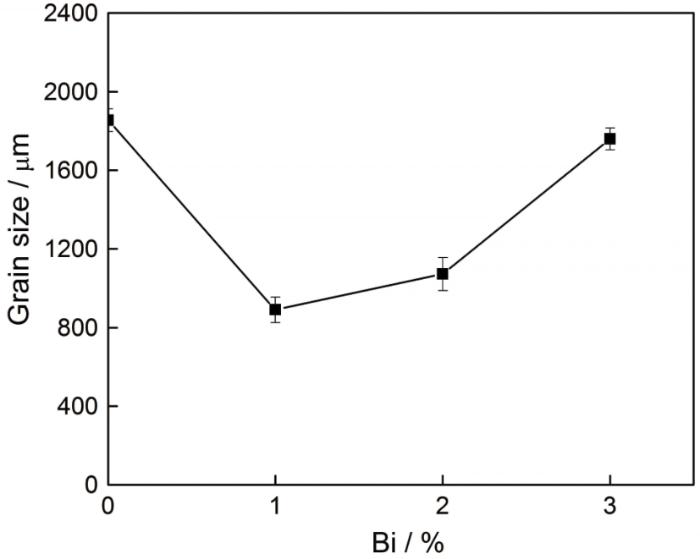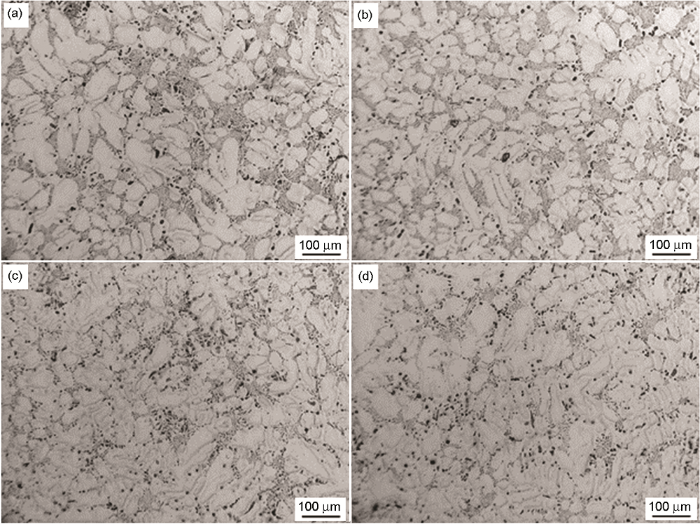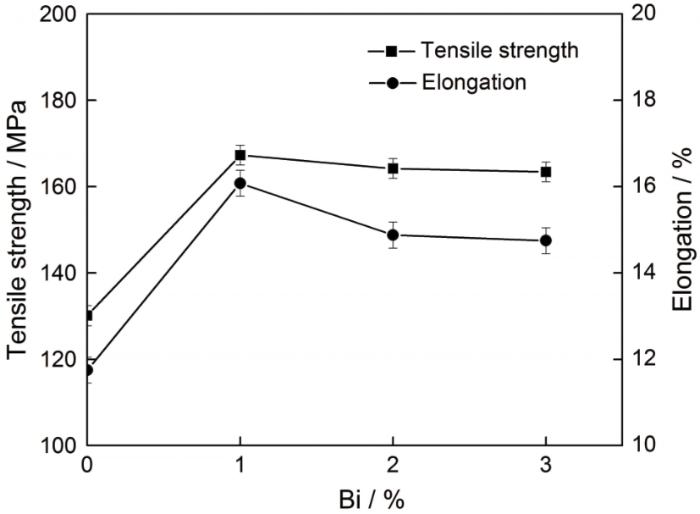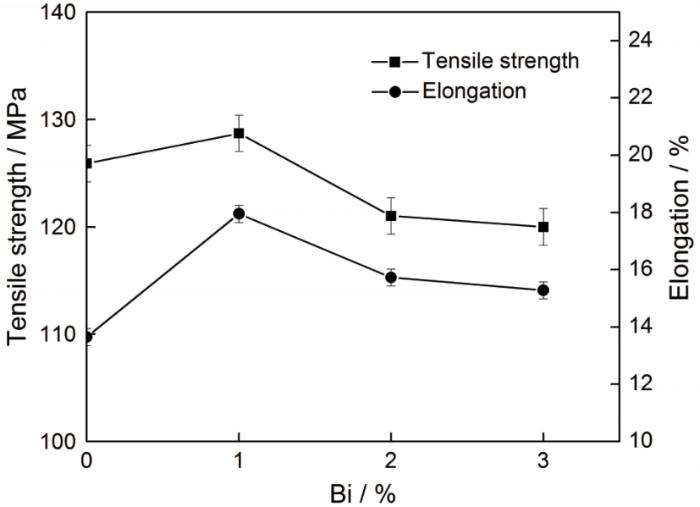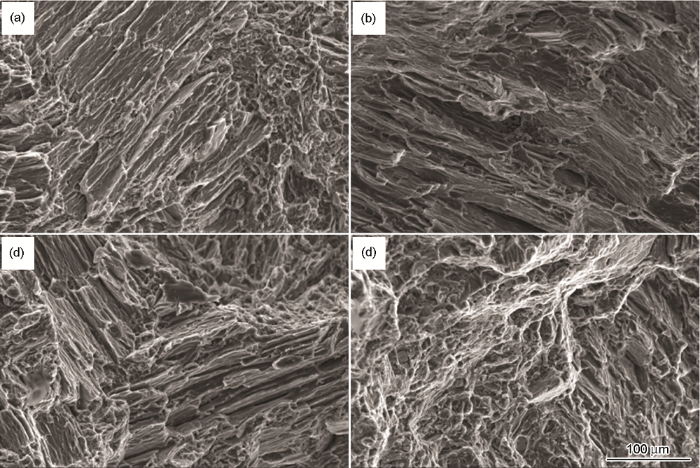添加RE元素可提高Mg-Al合金高温性能。在AZ91镁合金中加入稀土元素Y可生成耐高温的Al2Y相和细化组织,提高其室温和高温性能[10]。在AZ31镁合金中加入Nd使镁合金的抗拉强度和伸长率有一定程度的提高[11]。添加Bi,也能提高镁合金的室温和高温性能。任文亮等[12]研究了Bi对AZ81镁合金组织和力学性能的影响,发现添加0.5%~2.5%(质量分数)的Bi使其铸态组织明显细化,在基体中生成热稳定性较高的颗粒相Mg3Bi2。添加Bi提高合金室温和高温力学性能的机理,是弥散强化和细晶强化。李涛[13]研究Bi对Mg-6Al-1Sm合金组织和性能的影响时发现,添加Bi后生成长条状和颗粒状Mg3Bi2相,虽然没有使合金的室温抗拉强度和延伸率明显提高,但是能显著改善其高温(150℃)力学性能。其原因是,添加Bi生成的高熔点Mg3Bi2相(熔点823℃)具有较高的热稳定性,弥散分布的Mg3Bi2相在高温下具有钉扎晶界的作用,对晶界移动的阻碍使合金的温力学性能提高。鉴于此,本文在Mg-3Al-3Nd镁合金中添加不同含量的Bi元素,研究Bi含量对Mg-3Al-3Nd镁合金的组织和性能影响。
1 实验方法
实验用Mg-3Al-3Nd-xBi(x=0,1,2,3)合金锭用井式电阻炉中熔炼,原料有:工业纯Mg(Mg≥99.5%,质量分数,下同),纯Al(Al≥99.9%),纯Bi(Bi≥99.95%)和Mg-30%Nd中间合金。为确保合金在熔炼过程中不氧化,加入RJ-2覆盖剂溶体。纯Mg完全熔化后升温至760℃,保温10 min后加入纯Al、纯Bi和Mg-30%Nd中间合金。原料全部熔化后机械搅拌1 min以使其均匀,将其在720℃静置10 min后除渣,然后浇入预热温度为250℃的金属型模具。合金的名义化学成分列于表1。
表1 实验合金的名义成分
Table 1
| Alloys | Al | Nd | Bi | Mg |
|---|---|---|---|---|
| Mg-3Al-3Nd | 3 | 3 | 0 | Bal. |
| Mg-3Al-3Nd-1Bi | 3 | 3 | 1 | Bal. |
| Mg-3Al-3Nd-2Bi | 3 | 3 | 2 | Bal. |
| Mg-3Al-3Nd-3Bi | 3 | 3 | 3 | Bal. |
将金相试样打磨和抛光后用苦味酸(10 mL乙酸、6 g苦味酸、8 mL水、70 mL乙醇)腐蚀,用DV320型立式显微镜观察低倍光学显微组织并用截线法测量晶粒尺寸。晶粒尺寸的定义为截线长度与截线穿过晶界数目之比,所画截线应尽可能多地截割晶粒,每张图片选取5次视场进行测定,取其结果的平均值。用GX71型金相显微镜和Apreo C型扫描电镜观察微观组织,用4%硝酸酒精溶液腐蚀试样。用X´pert Pro型X射线衍射仪标定物相,试验电压40 kV,采用Cu靶,扫描速度4°/min,扫描范围10°~90°。在MST-200型电子万能拉伸试验机上进行室温及高温(150℃)拉伸试验,高温拉伸时将试样以10℃/min的速度升温至150℃,保温20 min后进行实验,试样的尺寸如图1所示,拉伸速率为1 mm/min。用Apreo C型扫描电镜观察断口的形貌。
图1
2 结果和分析
2.1 Bi对Mg-3Al-3Nd合金显微组织的影响
图2
图2
Mg-3Al-3Nd-xBi合金的低倍光学显微组织
Fig.2
Low power optical micrographs of Mg-3Al-3Nd-xBi alloy (a) Mg-3Al-3Nd; (b) Mg-3Al-3Nd-1Bi; (c) Mg-3Al-3Nd-2Bi; (d) Mg-3Al-3Nd-3Bi
图3
图4给出了不同Bi含量Mg-3Al-3Nd合金的XRD衍射图谱,可见未添加Bi的Mg-3Al-3Nd合金主要由基体α-Mg、Al11Nd3和Al2Nd相组成,与前人的研究结果一致[14,15]。在添加1%Bi合金的衍射谱中出现了BiNd相的衍射峰,且随着Bi含量的提高BiNd相的衍射峰增强。当Bi含量高于1%时Al2Nd相的衍射峰消失,表明添加Bi抑制了Al2Nd相的生成。图5给出了不同Bi含量Mg-3Al-3Nd合金的光学显微组织,可见未添加Bi的Mg-3Al-3Nd合金为树枝晶组织,大量的网状第二相分布于枝晶之间;添加Bi的合金仍为树枝晶组织,随着Bi含量的提高枝晶尺寸先减小后增加,枝晶间网状相逐渐减少。
图4
图4
Mg-3Al-3Nd-xBi合金的XRD衍射图谱
Fig.4
XRD diffraction patterns of Mg-3Al-3Nd-xBi alloy
图5
图5
Mg-3Al-3Nd-xBi合金的光学显微组织
Fig.5
Optical micrographs of the Mg-3Al-3Nd-xBi Alloy (a) Mg-3Al-3Nd; (b) Mg-3Al-3Nd-1Bi; (c) Mg-3Al-3Nd-2Bi; (d) Mg-3Al-3Nd-3Bi
为了更清楚的观察不同Bi含量Mg-3Al-3Nd合金中第二相的分布,对铸态合金进行了SEM观察,图6给出了不同Bi含量Mg-3Al-3Nd合金的SEM照片。如图6a和图6e所示,未添加Bi的Mg-3Al-3Nd合金中第二相由网状析出相与少量圆形的颗粒相组成;如图6b和图6f所示,添加1%B合金的组织中网状析出相的连续性减弱,出现方块状颗粒相,圆形颗粒相减少;如图6c和图6g所示,添加2%Bi的合金,网状相尺寸减小且在基体中的分布更加弥散,圆形颗粒相消失,方块状颗粒相数量增多且出现粗化;如图6d和图6h所示,添加3%Bi的合金,网状相明显减少,方块状颗粒相数量增多,平均尺寸变大。表2给出了图6中各典型相的EDS能谱分析结果,结合XRD和SEM结果可确定合金中第二相的类型。在Mg-3Al-3Nd-xBi合金中网状析出相A、D、F、H主要含有Mg、Al和Nd元素,Al与Nd的原子比接近11:3,为Al11Nd3相;圆形颗粒相B、C主要含有Mg、Al和Nd元素,Al与Nd的原子比接近2:1,为Al2Nd相;方块颗粒相E、G、I主要含有Mg、Bi和Nd元素,Bi与Nd的原子比接近1:1,为BiNd相。
图 6
图 6
Mg-3Al-3Nd-xBi合金的SEM形貌
Fig.6
SEM morphology of Mg-3Al-3Nd-xBi alloy (a) (e) Mg-3Al-3Nd; (b) (f) Mg-3Al-3Nd-1Bi; (c) (g) Mg-3Al-3Nd-2Bi; (d) (h) Mg-3Al-3Nd-3Bi
表2 图6中各点EDS分析结果(原子分数,%)
Table 2
| Point | Mg | Al | Nd | Bi | Phases |
|---|---|---|---|---|---|
| A | 38.46 | 44.55 | 17.00 | 0.00 | Al11Nd3 |
| B | 58.54 | 26.65 | 14.77 | 0.04 | Al2Nd |
| C | 53.85 | 28.64 | 15.51 | 0.00 | Al2Nd |
| D | 46.54 | 42.8 | 10.58 | 0.08 | Al11Nd3 |
| E | 4.28 | 0.00 | 49.04 | 46.68 | BiNd |
| F | 15.43 | 67.24 | 17.33 | 0.00 | Al11Nd3 |
| G | 3.85 | 0.00 | 47.65 | 48.5 | BiNd |
| H | 45.89 | 42.26 | 11.85 | 0.00 | Al11Nd3 |
| I | 8.49 | 0.00 | 46.54 | 44.97 | BiNd |
根据上述分析,在Mg-3Al-3Nd合金中添加Bi后Al11Nd3和Al2Nd相逐渐被BiNd相取代。可以推测,Bi优先与Nd反应。金属间化合物能否生成与其生成焓有关,生成焓越负金属间化合物越容易生成。使用Miedema二元合金生成焓半经验模型计算相的生成焓,Miedema模型的数学式为[16]
和
其中xA和xB分别为A和B的摩尔分数,V为摩尔体积,nws为电子密度,Φ为电负性,p、q、r、a、μ为经验参数,参照文献[17]和[18]选取物理和经验参数。合金中各相生成焓的计算值,列于表3。由计算结果可知,Al-Nd相的生成焓小于Mg-Al和Mg-Nd相的生成焓。这表明,在相同的条件下在Mg-Al-Nd系合金中优先生成Al-Nd相;Bi-Nd相的生成焓小于Al-Nd相的生成焓,在Mg-Al-Nd-Bi系合金中Bi-Nd相优先生成。因此,在Mg-3Al-3Nd合金中第二相主要为Al-Nd相(Al2Nd和Al11Nd3相),而添加Bi后BiNd相优先形成,Al-Nd相形成受到抑制。随着Bi含量的提高BiNd相含量增加,而Al2Nd和Al11Nd3相含量逐渐减少。
表3 Mg-Al-Nd-Bi合金中各相生成焓 (kJ/mol)
Table 3
| Phases | Mg-Al | Mg-Nd | Al-Nd | Bi-Mg | Bi-Al | Bi-Nd |
|---|---|---|---|---|---|---|
| △H | -1.85 | -10.98 | -58.74 | -9.61 | 9.31 | -85.48 |
2.2 Bi对Mg-3Al-3Nd合金室温力学性能影响
Mg-3Al-3Nd-xBi合金在室温下的拉伸性能,如图7所示。可以看出,随着Bi含量的提高合金的抗拉强度和延伸率均先升高后降低。添加1%Bi的合金,其抗拉强度和延伸率达到最大值,分别为167±2.3 MPa和(16.1±0.3)%,与Mg-3Al-3Nd合金相比,抗拉强度和延伸率分别提高37.2 MPa(提升了28.6%)和4.33% (提升了15.1%)。Bi含量高于1%的合金,其抗拉强度和延伸率均有所降低。在体积和变形量相同的情况下,晶粒越细参与变形的晶粒越多,每个晶粒的受力就越均匀,难以产生应力集中 [23,24,25],合金的强度越高。添加1%Bi的合金晶粒尺寸最小,细晶强化的效果最佳;在合金的变形过程中均匀分布的细小第二相对晶界的滑移与位错运动有明显的阻碍和钉扎作用[26,27,28],使合金的强度提高,第二相分布越均匀、尺寸越细小强化的效果越好。加入Bi生成BiNd相的同时还细化了Al11Nd3相,使第二相分布更加均匀,强化效果增强,合金力学性能提高。Bi的加入量过高使Al11Nd3相大量减少,强化相总量减少,第二相强化效果减弱,使合金的力学性能降低。
图7
图7
Mg-3Al-3Nd-xBi合金的室温拉伸性能
Fig.7
Tensile properties of Mg-3Al-3Nd-xBi alloy at room temperature
2.3 Bi对Mg-3Al-3Nd合金高温力学性能影响
Mg-3Al-3Nd-xBi合金的高温(150℃)拉伸性能,如图8所示。与室温相比,Mg-3Al-3Nd-xBi合金的高温抗拉强度降低,延伸率提高。抗拉强度和延伸率的变化趋势与室温下的情况大致相同,Bi含量为1%时合金高温抗拉强度和延伸率达到最大值,分别为136±1.7MPa和(19.3±0.3)%。与Mg-3Al-3Nd合金相比,高温抗拉强度和延伸率分别提高了20.6 MPa(提升了17.8%)和5.42%(提升了18.3%)。Bi含量高于1%的合金,其抗拉强度和延伸率均有所下降。在高温下晶界滑移是变形的主要机制,晶界越细小晶界越多,晶界滑移越容易发生。因此,细化晶粒不利于提高材料的高温性能。本文在Mg-3Al-3Nd合金中添加1%Bi使其晶粒尺寸减小,但是高温抗拉强度提高。产生这一现象的主要原因是,在Mg-3Al-3Nd-Bi合金中有大量细小弥散分布的Al11Nd3和BiNd相。Al11Nd3和BiNd相的熔点较高,热稳定性也较高。分布在晶界附近的Al11Nd3和BiNd相在高温下钉扎相邻晶粒的移动用,阻碍晶界滑动而使合金的高温强度提高[29]。因此,试验合金具有良好高温强度,是热稳定第二相引起的弥散强化和细晶强化的共同结果。随着Bi含量的提高Al11Nd3相大量减少,强化相总量减少,对晶界的钉扎作用减弱,使高温强度降低。
图8
图8
Mg-3Al-3Nd-xBi合金的高温拉伸性能
Fig.8
Tensile properties of Mg-3Al-3Nd-xBi alloy at high temperature
2.4 Bi对Mg-3Al-3Nd合金的拉伸断口形貌影响
图 9
图 9
Mg-3Al-3Nd-xBi合金室的室温拉伸断口形貌
Fig.9
Room temperature tensile fracture morphology of as-cast Mg-3Al-3Nd-xBi alloy (a) Mg-3Al-3Nd; (b) Mg-3Al-3Nd-1Bi; (c) Mg-3Al-3Nd-2Bi; (d) Mg-3Al-3Nd-3Bi
Mg-3Al-3Nd-xBi合金在150℃的拉伸断口形貌,如图10所示。可以看出,在Mg-3Al-3Nd-xBi合金试样的基体上有许多大小、深浅及形状不同的韧窝和撕裂带。这表明,试样断裂前α-Mg基体发生了较大的塑性变形。与Mg-3Al-3Nd-xBi合金的室温拉伸断口形貌相比,试样的断口上韧窝数量增加,试样的变形程度提高。如图10a所示,在Mg-3Al-3Nd断口表面有较大的解理面,韧窝较少,属于韧脆混合型断口;如图10b所示,添加1%Bi的合金断口,解理面变窄,韧窝数量增加,且细小韧窝比例上升,表明合金的性能有所提高;如图10c所示,添加2%Bi后,断口表面韧窝数量减少且韧窝较浅,表明合金的力学性能有所下降;如图10d所示,Mg-3Al-3Nd-3Bi合金断口表面出现撕裂棱,除韧窝外在韧窝内还有颗粒状组织,在断口上还能观察到微裂纹。其原因是,颗粒状BiNd相在拉伸过程中诱发应力集中,割裂基体而形成裂纹,使合金的力学性能降低。
图 10
图 10
Mg-3Al-3Nd-xBi合金的高温拉伸断口形貌
Fig.10
High temperature tensile fracture morphology of Mg-3Al-3Nd-xBi alloy (a) Mg-3Al-3Nd; (b) Mg-3Al-3Nd-1Bi; (c) Mg-3Al-3Nd-2Bi; (d) Mg-3Al-3Nd-3Bi
3 结论
(1) 添加Bi可细化Mg-3Al-3Nd合金的组织,其平均晶粒尺寸为1854±58 μm,加入Bi元素后晶粒尺寸先减小后增加,添加1%Bi时平均晶粒尺寸达到最小值890±64 μm,比未添加Bi时降低了108.3%,进一步提高Bi含量细化效果减弱。
(2) 在Mg-3Al-3Nd镁合金中加入适量的Bi能改善合金的铸态组织分布,Mg-3Al-3Nd合金主要由呈网状分布在晶界的Al11Nd3相和分布在晶内的颗粒状Al2Nd组成;随着Bi含量的提高Al11Nd3相和Al2Nd相的数量减少,晶内的BiNd相数量增加。
(3) Bi的加入使Mg-3Al-3Nd合金室温和高温力学性能明显提高,Bi含量为1%的合金室温和高温力学性能最佳,室温抗拉强度和延伸率分别为167±2.3 MPa和(16.1±0.3)%,高温抗拉强度及延伸率分别为136±1.7 MPa和(19.3±0.3)%。
参考文献
Discussions on grain refinement of magnesium alloys by carbon inoculation
[J].
Influence of solution treatment on the corrosion fatigue behavior of an as-forged Mg-Zn-Y-Zr alloy
[J].
Effect of Nd addition on microstructure and corrosion resistance of AZ91 magnesium alloy
[J].
Nd对AZ91镁合金显微组织和耐腐蚀性能的影响
[J].
Research Progress on the Corrosion Behavior of Magnesium-Lithium-Based Alloys: A Review
[J].In this review paper, the research progress on corrosion behavior of hexagonal close-packed (HCP) singular phase, body cubic-centered (BCC) singular phase and (HCP?+?BCC) duplex-structured Mg-Li alloys has been summarized and reviewed, and the future trend about the studies on corrosion behavior of Mg-Li-based alloys and possible solving methods for the improvement in corrosion resistance are discussed also.
Effect of Pb and Sb additions on the precipitation kinetics of AZ91 magnesium alloy
[J].
Recent progress in the research about fatigue crack initiation of Mg alloys under elastic stress amplitudes: A review
[J].
Development status and prospect of heat resistant rare earth-magnesium alloy
[J].
稀土耐热镁合金发展现状及展望
[J].
Improvement of mechanical properties of Mg-Al based alloy by bismuth alloying
[J]. J
Mg-Al基合金加铋合金化对其力学性能的改善作用
[J].
Research and application of rare earth in heat resistant magnesium alloy
[J].
稀土在耐热镁合金中的研究应用
[J].
Effects of Yttrium on microstructure and mechanical properties of AZ91D magnesium alloy
[J].
稀土元素Y对AZ91D镁合金显微组织和力学性能的影响
[J].
Synergistic effects of Nd and Y on microstructure and properties of AZ31 magnesium alloy
[D].
Nd和Y复合添加对AZ31镁合金组织与性能的影响
[D].
Effect of Bismuth addition on the microstructure and mechanical properties of AZ81 magnesium Alloy
[J].
Bi对AZ81镁合金组织和力学性能的影响
[J].
Influence of Sm, Bi, Zn and casting process on microstructures and mechanical properties of Mg-6Al magnesium alloy
[D].
Sm、Bi、Zn及压铸对Mg-6Al系镁合金组织和性能的影响
[D].
Effect of A1-Nd compound on the microstructure and mechanical properties of Mg-A1 magnesium alloys
[D].
Al-Nd化合物对Mg-Al系镁合金显微组织和力学性能的影响
[D].
Effect of neodymium on the as-cast microstructure andmechanical properties of AZ31 magnesium alloy
[J].
稀土Nd对AZ31镁合金铸态组织和力学性能的影响
[J].
Microstructures and mechanical properties of as-cast Mg-5Al-0.4Mn-xNd(x=0, 1, 2 and 4) alloys
[J].
Effect of Al-and Ce-content on microstructure of Mg-Al magnesium alloys
[J].
Al和Ce的含量对Mg-Al合金组织的影响
[J].
Calculation of thermodynamic parameters of Mg-Al-Y alloy
[J].
Investigation on diffusion behaviors of alloy elements in magnesium
[D].
合金元素在镁合金中扩散行为的研究
[D].
Effect of Nd addition on microstructures and mechanical properties of AZ80 magnesium alloys
[J].
Crystallography of heterogeneous nucleation of Mg grains on Al2Y nucleation particles in an Mg-10%Y alloy
[J].
Grain refinement of aluminum alloys: Part I. the nucleant and solute paradigms-a review of the literature
[J].
Investigations on hot tearing behavior of Mg-7Zn-xCu-0.6Zr alloys
[J].xCu-0.6Zr (x=0, 1, 2, 3) alloys was studied using with T type hot tearing mold. The microstructure and the morphology of cracking zone of Mg-7Zn-xCu-0.6Zr (x=0, 1, 2, 3) alloys were observed by XRD and SEM, respectively. The hot cracking susceptibility of Mg-7Zn-xCu-0.6Zr (x=0, 1, 2, 3) alloys were characterized by the measurement of crack volume. The experimental results show that the grain sizes of Mg-7Zn-0.6Zr alloys were refined by addition of Cu element. Meanwhile, the amount of eutectic phase was increased with increasing the Cu content and the separated dendritic was refilled by the eutectic phase. Hot tearing susceptibility of Mg-7Zn-0.6Zr was decreased with increasing of Cu content. The Mg-7Zn-0.6Zr and Mg-7Zn-1Cu-0.6Zr alloys were completely broken. The hot cracks of Mg-7Zn-xCu-0.6Zr (x=0, 1, 2, 3) alloys were formed by liquid film, solidification shrinkage and interdendritic bridge.]]>
Mg-7Zn-xCu-0.6Zr合金热裂行为的研究
[J].xCu-0.6Zr (x=0、1、2、3)合金热裂行为的影响。利用XRD和SEM对Mg-7Zn-xCu-0.6Zr (x=0、1、2、3)合金进行了显微组织和热裂区域组织形貌观察。通过测量热裂纹体积表征了Mg-7Zn-xCu-0.6Zr (x=0、1、2、3)合金的热裂倾向性。实验结果表明,Mg-7Zn-xCu-0.6Zr (x=0、1、2、3)合金中随着Cu含量的增加,晶粒得到细化,晶界上的共晶相增多,共晶相在凝固末期对分离的枝晶起到补缩的作用,降低合金热裂倾向性。研究表明,Mg-7Zn-xCu-0.6Zr (x=0、1、2、3)合金微观裂纹的形成是液膜、凝固收缩补偿和晶间搭桥共同作用的结果。]]>
Current research progress in grain refinement of cast magnesium alloys: A review article
[J].
Effect of Nd on the microstructure, mechanical properties and corrosion behavior of die-cast Mg-4Al-based alloy
[J].
Texture investigation on the deformation mechanisms inmagnesium alloy AZ31 deformed at high temperatures
[J].
镁合金AZ31高温形变机制的织构分析
[J].
Effect of Bi, Sb and Ca additions on the hot hardness and microstructure of cast Mg-5Sn alloy
[J].






